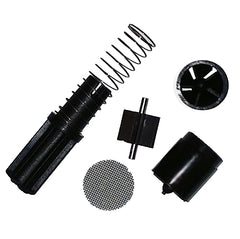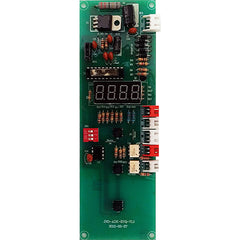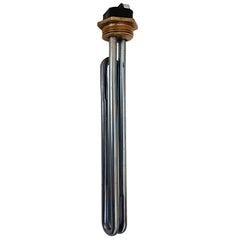Tankless 101: What is a tankless water heater?
Section 1: What is a tankless water heater?
It's just one of those terms that really needs no further definition, like "cordless telephone" or "solar powered calculator" or "hippopotomonstrosesquipedaliophobia". However, in keeping with the spirit of actual definitions, a tankless water heater would be defined as: - noun. An apparatus for heating water that does not have a storage tank. (as for domestic use). - It would be prudent however to provide some explanation, after all, that is why you're here!
Flow Switch
 An electric tankless water heater is typically a small, square or rectangular wall mounted appliance that measures about 12 X 12 X 4in. (30.48 X 30.48 X 10.16cm) like the iHeat ADK S-12 seen above. It heats water only when hot water is needed, by turning on with some form of water flow detection sensor. In some cases these sensors are magnetic in others they are centrifugal and in others they are rotary or fan based. In any case, it is the flow sensor inside the tankless heater that detects when you turn on the hot water faucet at your kitchen sink or your shower for example.
An electric tankless water heater is typically a small, square or rectangular wall mounted appliance that measures about 12 X 12 X 4in. (30.48 X 30.48 X 10.16cm) like the iHeat ADK S-12 seen above. It heats water only when hot water is needed, by turning on with some form of water flow detection sensor. In some cases these sensors are magnetic in others they are centrifugal and in others they are rotary or fan based. In any case, it is the flow sensor inside the tankless heater that detects when you turn on the hot water faucet at your kitchen sink or your shower for example.
Control Board
 Once the heater detects the flow of water through it, the control board starts to make some calculations. These calculations are based on several factors and it is the control board that takes queues from various sensors throughout the heater. In general terms, the control board is the brains of the entire operation. Much like any other electronic PC board, it has chips and firmware that make it all happen. As you can imagine, the more complex the hardware and software on the board, the more complex the operation of the heater. This typically leads to better performing and more technologically advanced heating and modulating of water temperature and flow.
Once the heater detects the flow of water through it, the control board starts to make some calculations. These calculations are based on several factors and it is the control board that takes queues from various sensors throughout the heater. In general terms, the control board is the brains of the entire operation. Much like any other electronic PC board, it has chips and firmware that make it all happen. As you can imagine, the more complex the hardware and software on the board, the more complex the operation of the heater. This typically leads to better performing and more technologically advanced heating and modulating of water temperature and flow.
Temperature Sensors
 Speaking of temperature and sensors, tankless water heaters with advanced feature sets typically have more than one temperature sensor. These temperature sensors detect the temperature of incoming and outgoing water and report back to the control board. Based on the information that is returned, the control board, at a rate of several thousand calculations per minute, determines how much power should be sent to the heating elements in order to accomplish the task of heating water to the specified temperature setting.
Speaking of temperature and sensors, tankless water heaters with advanced feature sets typically have more than one temperature sensor. These temperature sensors detect the temperature of incoming and outgoing water and report back to the control board. Based on the information that is returned, the control board, at a rate of several thousand calculations per minute, determines how much power should be sent to the heating elements in order to accomplish the task of heating water to the specified temperature setting.
Heating Elements
 In electric tankless water heaters, the heating elements are responsible for the actual task of heating the water. Heating elements, in simple terms, are electronic resistors that heat up as an electric current is passed through them, much like the element that turns cherry red on your stove top. They are coiled but unlike your stove top however, they are cylindrical in shape. These resistors are encased in some kind of metal heat exchanger, typically copper or stainless steel and secured in place by either screwing them in or bolting them on. The heating elements are rated based on Watts and vary from heater to heater. A tankless water heater with two 6000 Watt (6 Kilowatt) heating elements would be rated at 12,000 Watts or more commonly 12 (kilo) watts. i.e. 12KW. As you can imagine, the higher the KW rating, the greater the tankless water heater's capacity for heating water.
In electric tankless water heaters, the heating elements are responsible for the actual task of heating the water. Heating elements, in simple terms, are electronic resistors that heat up as an electric current is passed through them, much like the element that turns cherry red on your stove top. They are coiled but unlike your stove top however, they are cylindrical in shape. These resistors are encased in some kind of metal heat exchanger, typically copper or stainless steel and secured in place by either screwing them in or bolting them on. The heating elements are rated based on Watts and vary from heater to heater. A tankless water heater with two 6000 Watt (6 Kilowatt) heating elements would be rated at 12,000 Watts or more commonly 12 (kilo) watts. i.e. 12KW. As you can imagine, the higher the KW rating, the greater the tankless water heater's capacity for heating water.
Heat Exchangers
 For all intents and purposes, all of the water flow that goes through a tankless water heater actually flows through the heat exchanger. As mentioned above, the heat exchanger houses the heating elements, and in addition, provides a sealed vessel for water to flow through as it is heated from cold to hot. This "exchange" of cold to hot is where this part of the heater derives it's name. The heat exchanger is typically comprised of two or more cylinders that are slightly larger than the heating elements and welded together with tubes that allow for water to progressively pass from the first (leading) heating element to the last (trailing) heating element and get successively hotter. Depending on the heating capacity of the elements, and how many of them, the water will enter through the inlet side of the heater at one temperature, pass through the heat exchanger and exit through the outlet side of the heater at a higher temperature achieving a specific "temperature differential" commonly know as "Delta T" (ΔT) in scientific terminology, specifically chemistry. This temperature differential is the key to selecting the proper heater for your home or application and is discussed at length in the "How do I know which one is best for my home?" section.
For all intents and purposes, all of the water flow that goes through a tankless water heater actually flows through the heat exchanger. As mentioned above, the heat exchanger houses the heating elements, and in addition, provides a sealed vessel for water to flow through as it is heated from cold to hot. This "exchange" of cold to hot is where this part of the heater derives it's name. The heat exchanger is typically comprised of two or more cylinders that are slightly larger than the heating elements and welded together with tubes that allow for water to progressively pass from the first (leading) heating element to the last (trailing) heating element and get successively hotter. Depending on the heating capacity of the elements, and how many of them, the water will enter through the inlet side of the heater at one temperature, pass through the heat exchanger and exit through the outlet side of the heater at a higher temperature achieving a specific "temperature differential" commonly know as "Delta T" (ΔT) in scientific terminology, specifically chemistry. This temperature differential is the key to selecting the proper heater for your home or application and is discussed at length in the "How do I know which one is best for my home?" section.
Section 2: Why should I care?
Section 3: When should I consider using one?
Section 4: How do I know which one is best for my home?
DID YOU LEARN SOMETHING NEW? PLEASE REMEMBER TO SHARE!

